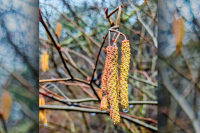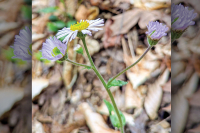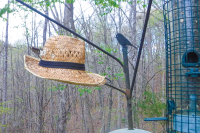Notes from a plant nerd: Worts and All
 The leaves of the hepatica are visible all year long, and their flowers are some of the first to bloom in spring. Adam Bigelow photo
The leaves of the hepatica are visible all year long, and their flowers are some of the first to bloom in spring. Adam Bigelow photo
Among the duff of last year’s fallen leaves lie many interesting and beautiful shapes to catch your eye on a winter’s walk in the woods. From the mosses and orchid leaves described in previous columns, to newly emerging plants preparing for spring’s full flush, there are many forms and patterns on the winter forest’s floor.
One of my favorite leaf shapes that can be seen all year long is also among the first wildflowers to bloom in the spring, and belongs to the plant called liverwort, liverleaf, or hepatica (Hepatica spp.) Growing in clusters that can carpet spots where the plant is happy, liverwort blooms in early spring, or what most people would actually consider winter. Not me, though. If there are spring flowers, it’s spring. And liverwort blooms in spring.
While all of the native spring wildflowers of Southern Appalachia are commonly referred to as “spring ephemerals” liverworts are not “true spring ephemerals,” because their leaves can be seen all year long. Ephemeral is a word in English that means short-lived or lasting for a very short time. Those plants considered to be true spring ephemerals like trout-lily (Erythronium spp.), spring beauty (Claytonia spp.) and cut-leaved toothwort (Cardamine concatenata) emerge from the ground, make leaves, produce flowers, get pollinated, set and distribute their seed and then die back to the ground all in a short span of a few weeks. They spend most of the year dormant underground, awaiting their time to bloom and shine.
Hepatica leaves, however, remain above ground for an entire year, dying back only as the new leaves emerge shortly after the flowers begin blooming. The leaf of liverwort starts as a bright green growth just as the flowers are beginning to fade. They mature into a dark green color with mottling on some leaves, which then turn a beautifully rich burgundy color in the fall. Each leaf is divided into three lobes, giving it a very distinct and easily identifiable shape.
There are two species of liverwort in the woods around us. The sharp-lobed hepatica (Hepatica acutiloba) has pointed ends at the tips of both the leaf and bracts, which are leafy growths holding the flowers from below. And there is the round-lobed hepatica (Hepatica americana) whose leaves and bracts are both rounded at the tips. Both plants have flowers that range from white, to pink, to blue. And no, the color change is not controlled by the pH of the soil, like in some exotic hydrangeas, but is due to genetic diversity within the species.
The shape and color of the leaves are the sources of both the common names liverwort and liverleaf, and its genus name of Hepatica, which relates to the liver. This is an example of the Doctrine of Signatures, the idea that if you sit and observe a plant for long enough, some part of the plant will resemble a body part, secretion, ailment or have some other indicator that it can be used to treat ailments and illnesses related to that observed characteristic.
Related Items
And while many of the old uses of medicinal plants discovered this way do hold up to modern scientific scrutiny, this is one that does not. The commonly used term “wort” found in many plant and flower names comes from an Old English word that originally meant “plant.” However, because people wouldn’t normally give names to plants unless there was a use, and therefore a need to remember it, wort took on the meaning of a useful or medicinal plant. There is toothwort, lungwort, spiderwort, birthwort and St. John’s wort to name just a few. It does make me wonder though, if there is a plant that could be used to remove small growths on the skin, would it be called a wart wort?
(Adam Bigelow lives in Cullowhee and leads weekly wildflower walks and ecotours through Bigelow’s Botanical Excursions. This email address is being protected from spambots. You need JavaScript enabled to view it..)













